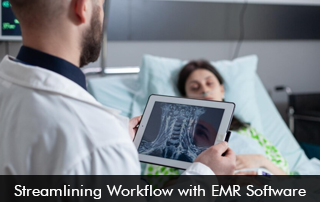One significant advancement that has transformed the healthcare industry is the adoption of EMR software. From general practices to specialized fields like allergy and nephrology, EMR software is revolutionizing the way patient information is managed and shared.
In this article, we will delve into the numerous benefits that EMR software offers to medical practices, and how it is an indispensable tool for streamlining workflow and enhancing patient care.
Understanding EMR Software
EMR software is a digital version of a patient’s paper chart. It is designed to store data accurately and streamline the patient information management process. With EMR software, healthcare providers can track patient data over time, easily identify which patients are due for preventive screenings or checkups, monitor patients’ progress, and improve overall quality of care within the practice.
Key Features of EMR Software
- Digital charting
- Appointment scheduling
- Medical billing
- E-prescribing
- Lab integration
- Reporting tools
The Benefits of EMR Software
Enhanced Patient Care
EMR software provides real-time access to patient health records, which means healthcare providers can make informed decisions quickly. This instant access to patient histories, allergies, treatment plans, and medications reduces the chances of medical errors and enhances the overall quality of care.
Improved Efficiency
EMR software automates many routine tasks such as patient scheduling, prescription refills, and the sending of lab orders. This automation reduces the administrative burden on staff, allowing them to focus more on patient care.
Secure Sharing of Patient Information
With EMR software, sharing patient information between healthcare providers is secure and efficient. Whether referring a patient to a specialist or coordinating care with a hospital, EMR software ensures that all relevant patient information is easily and securely accessible to authorized individuals.
Streamlined Documentation
Documentation is a critical but time-consuming task for healthcare providers. EMR software streamlines this process by providing templates and voice recognition features, which can significantly reduce the time spent on paperwork.
Better Management of Prescriptions
E-prescribing, a feature of many EMR systems, allows healthcare providers to send prescriptions directly to pharmacies electronically. This not only saves time but also minimizes prescription errors.
Choosing the Right EMR Software
When selecting an EMR system, practices should consider several factors to ensure that they choose software that best fits their specific needs.
Assessing Practice Needs
Understanding the workflow and identifying the bottlenecks within a practice is the first step in choosing the right EMR software. Each practice should evaluate its own requirements, whether it’s managing a high volume of allergy shots or tracking the progression of chronic kidney disease.
Considering Usability
The ease of use of EMR software is crucial for adoption and satisfaction among healthcare providers. Software with an intuitive interface and responsive customer support will ensure a smoother transition from paper charts to digital records.
Integrating With Other Systems
The ability to integrate with existing practice management systems, lab software, and other healthcare technologies is an important consideration. Seamless integration ensures that the practice can continue to operate without disruption.
Ensuring Compliance and Security
EMR software must comply with regulatory standards such as HIPAA to ensure the protection of patient information. It is essential to choose a system that prioritizes data security and patient privacy.
Implementing EMR Software
The implementation of EMR software involves careful planning and execution to minimize disruptions to the practice. Training staff, customizing the system to fit the practice’s needs, and gradually transitioning from paper to digital are key steps in the implementation process.
Training and Support
Proper training for all users of the EMR software is critical to its successful implementation. Providers should ensure that the chosen EMR vendor offers comprehensive training and ongoing support.
Customization and Personalization
Customizing the EMR software to align with the practice’s workflow and preferences can greatly enhance its effectiveness. Personalizing templates, creating shortcuts, and setting up specific user roles can make the system more user-friendly.
Gradual Transition
Switching to an EMR system is a significant change. It may be beneficial to start with a hybrid approach, maintaining both paper and digital records temporarily, to ensure that no data is lost or overlooked during the transition.
The Future of EMR Software
The future of EMR software is promising, with ongoing advancements in technology leading to more sophisticated and integrated systems. As artificial intelligence, telemedicine, and mobile health continue to evolve, EMR systems will play an even greater role in the transformation of healthcare delivery.








